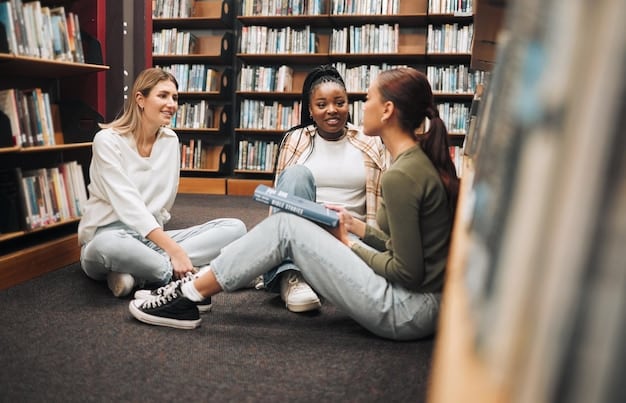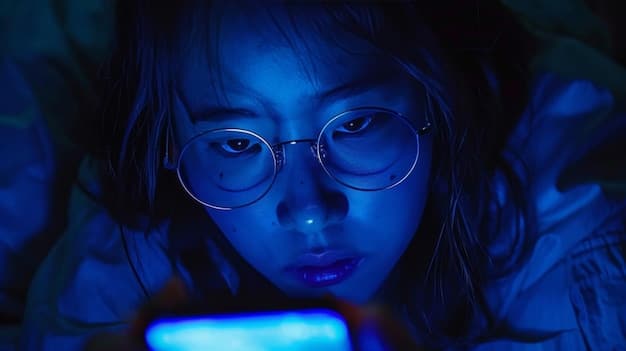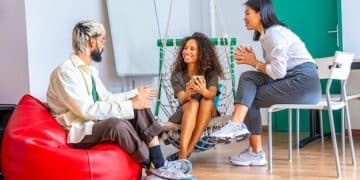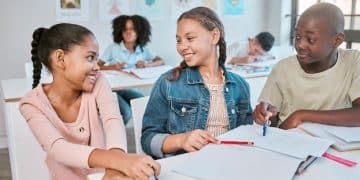The Impact of Social Media on Student Mental Health: Research & Interventions

The impact of social media on student mental health has become a significant area of concern, with new research continually emerging to understand its effects and inform interventions aimed at mitigating potential harm.
The ubiquitous nature of social media in the lives of students has sparked considerable debate about its impact on their mental well-being. New research is constantly emerging, shedding light on both the challenges and potential solutions. Let’s delve into the impact of social media on student mental health: new research and interventions.
Understanding the Social Media Landscape for Students
Social media has become an integral part of the student experience, offering platforms for connection, information sharing, and self-expression. However, this digital immersion also presents unique challenges to their mental health. It’s crucial to understand the various aspects of social media that influence students’ well-being.
The rise of platforms like Instagram, TikTok, and Twitter has fundamentally changed how students interact, learn, and perceive themselves. While these platforms offer benefits such as enhanced communication and access to information, they also bring potential risks like cyberbullying, social comparison, and addiction.
The Positive Aspects of Social Media for Students
Despite the challenges, social media can also provide valuable opportunities for students to enhance their mental well-being. Understanding these positive aspects is essential for promoting a balanced approach to social media use.
- Enhanced Connection: Social media allows students to stay connected with friends and family, especially those who are geographically distant, fostering a sense of belonging and reducing feelings of isolation.
- Access to Support Groups: Online communities and support groups on social media provide safe spaces for students to share their experiences and connect with others facing similar challenges, promoting emotional support and resilience.
- Information and Education: Social media platforms can be valuable sources of information, providing access to educational resources, mental health tips, and awareness campaigns.
- Self-Expression and Creativity: Social media offers students a platform to express themselves creatively, share their talents, and build their personal brand, fostering self-esteem and confidence.

Ultimately, while social media can be a powerful tool for connection and learning, it is crucial for students to be aware of both its positive and negative impacts on their mental health. Developing healthy online habits and seeking support when needed are essential for navigating the social media landscape safely and effectively.
The Negative Impacts of Social Media on Student Mental Health
While there are undeniable benefits to social media use, it is crucial to acknowledge the significant negative impacts it can have on student mental health. Understanding these risks is the first step in addressing them.
Increased rates of anxiety, depression, and body image issues have been linked to excessive social media use among students. The constant exposure to curated online personas and the pressure to maintain a perfect image can lead to feelings of inadequacy and low self-esteem.
Cyberbullying and Online Harassment
Cyberbullying is a pervasive issue on social media, with students often facing harassment, threats, and humiliation from their peers. This can have severe consequences on their mental health, leading to anxiety, depression, and even suicidal thoughts.
The anonymity and reach of social media make it a breeding ground for cyberbullying, as perpetrators can easily target victims without fear of immediate repercussions. Additionally, the permanence of online content means that victims may have to deal with the effects of cyberbullying for years to come.
Social Comparison and Body Image Issues
Social media often presents an unrealistic portrayal of reality, with users showcasing only the best aspects of their lives. This can lead to social comparison, where students constantly compare themselves to others, resulting in feelings of inadequacy and low self-esteem.
- Unrealistic Beauty Standards: Social media is rife with filtered images and edited videos that promote unrealistic beauty standards, causing students to feel insecure about their own appearance.
- Fear of Missing Out (FOMO): The constant stream of social events and activities shared on social media can lead to a fear of missing out, causing anxiety and feelings of isolation among students.
- Pressure to Achieve: Social media often showcases academic and professional achievements, creating pressure for students to constantly strive for success and leading to feelings of inadequacy when they fall short.
It is important for students to be aware of the potential negative impacts of social media and to develop healthy online habits, such as limiting their time on social media, being mindful of the content they consume, and seeking support when needed.
New Research on Social Media and Student Well-being
Recent studies continue to explore the complex relationship between social media and student mental health, providing valuable insights into the specific mechanisms through which social media impacts well-being. Staying informed about these findings is crucial for developing effective intervention strategies.
Researchers are increasingly focusing on the specific platforms and types of content that are most detrimental to student mental health. Additionally, studies are examining the role of individual factors, such as personality traits and pre-existing mental health conditions, in moderating the impact of social media.
Specific Platforms and Mental Health Outcomes
Research suggests that certain social media platforms may be more strongly associated with negative mental health outcomes than others. Understanding these platform-specific effects is crucial for tailoring interventions and promoting responsible social media use.
For example, studies have found that platforms like Instagram, which are heavily focused on visual content and social comparison, may be particularly detrimental to body image and self-esteem. Conversely, platforms like LinkedIn, which are more professionally oriented, may have a different impact on mental health.
The Role of Passive vs. Active Social Media Use
The way in which students use social media can also influence its impact on their mental health. Passive consumption, such as scrolling through feeds without actively engaging, has been linked to increased feelings of loneliness and depression. Active engagement, such as posting content and interacting with others, may have a more positive or neutral effect.
One study found that students who spent more time passively browsing social media were more likely to report symptoms of depression and anxiety, while those who actively engaged with others online experienced a greater sense of social connection and belonging.

Staying informed about the latest research on social media and student well-being is essential for educators, parents, and students themselves. By understanding the specific mechanisms through which social media impacts mental health, we can develop more effective strategies for promoting responsible use and mitigating potential harm.
Intervention Strategies for Supporting Student Mental Health
Given the potential negative impacts of social media on student mental health, it is crucial to implement effective intervention strategies that promote responsible use and provide support to those who are struggling.
These strategies should involve a multi-faceted approach, including education, prevention, and treatment, and should be tailored to the specific needs of students and the unique challenges they face in the digital world.
Promoting Digital Literacy and Media Awareness
One of the most effective intervention strategies is to promote digital literacy and media awareness among students. This involves educating them about the potential risks of social media, as well as how to use these platforms responsibly and critically evaluate online content.
Digital literacy programs should cover topics such as cyberbullying prevention, online privacy and security, and how to identify and challenge unrealistic beauty standards promoted on social media. Students should also be taught how to manage their time online and develop healthy boundaries with social media.
Mental Health Support and Resources
Providing access to mental health support and resources is essential for students who are struggling with the negative impacts of social media. This includes offering counseling services, support groups, and online resources that address issues such as anxiety, depression, and body image issues.
- On-Campus Counseling Centers: Colleges and universities should provide accessible and affordable counseling services to students, staffed by trained mental health professionals who can offer support and guidance.
- Online Mental Health Resources: Online resources, such as websites, apps, and virtual support groups, can provide students with convenient and confidential access to mental health information and support.
- Peer Support Programs: Peer support programs, where students are trained to provide support and guidance to their peers, can be an effective way to promote mental health and reduce stigma around seeking help.
By implementing these intervention strategies, we can help students navigate the social media landscape safely and responsibly, promoting their mental health and well-being in the digital age.
The Role of Parents and Educators in Guiding Students
Parents and educators play a crucial role in guiding students towards responsible social media use and supporting their mental health. By working together, they can create a supportive environment that promotes digital well-being and mitigates potential harm.
Open communication, education, and setting healthy boundaries are key to helping students navigate the complexities of the online world and develop a positive relationship with social media.
Open Communication and Education
Open communication between parents, educators, and students is essential for fostering trust and creating a safe space for students to discuss their experiences with social media. Parents and educators should encourage students to share their concerns, challenges, and successes related to social media, and provide them with guidance and support.
Educating students about the potential risks and benefits of social media is also crucial. Parents and educators should teach students about cyberbullying prevention, online privacy and security, and how to critically evaluate online content. They should also encourage students to be mindful of the time they spend on social media and to develop healthy online habits.
Setting Healthy Boundaries and Expectations
Setting healthy boundaries and expectations around social media use is essential for promoting responsible behavior and protecting students’ mental health. Parents and educators should work together to establish clear guidelines for social media use, including limits on screen time, restrictions on certain types of content, and expectations for online behavior.
- Screen Time Limits: Setting limits on the amount of time students spend on social media each day can help them to develop healthier habits and reduce the risk of addiction and negative mental health outcomes.
- Content Restrictions: Restricting access to certain types of content, such as violent or sexually explicit material, can protect students from harmful influences and promote a more positive online experience.
- Expectations for Online Behavior: Establishing clear expectations for online behavior, such as treating others with respect and avoiding cyberbullying, can help to create a safer and more supportive online environment.
By working together, parents and educators can provide students with the guidance and support they need to navigate the social media landscape safely and responsibly, promoting their mental health and well-being in the digital age.
Future Directions in Research and Intervention
As social media continues to evolve, it is crucial to continue researching its impact on student mental health and to develop innovative intervention strategies that address the unique challenges of the digital age.
Future research should focus on identifying the specific factors that make certain students more vulnerable to the negative impacts of social media, as well as exploring the potential for social media to be used as a tool for promoting mental health and well-being.
Personalized Interventions and AI-Powered Support
Personalized interventions, tailored to the individual needs and characteristics of students, may be more effective than one-size-fits-all approaches. This includes using data analytics and machine learning to identify students who are at risk of developing mental health problems related to social media use and providing them with targeted support and resources.
AI-powered chatbots and virtual assistants can also be used to provide students with 24/7 access to mental health information and support, as well as to monitor their social media activity for signs of distress or cyberbullying.
Harnessing Social Media for Positive Change
Rather than simply focusing on the negative impacts of social media, future research should also explore the potential for social media to be used as a tool for promoting mental health and well-being. This includes developing online interventions that encourage students to connect with others, share their experiences, and access mental health resources.
Social media can also be used to raise awareness about mental health issues and to reduce stigma around seeking help. By creating positive and supportive online communities, we can help students to feel more connected and less alone, promoting their overall well-being.
| Key Point | Brief Description |
|---|---|
| 👍 Positive Aspects | Social media can enhance connection and provide access to support. |
| 😔 Negative Impacts | Cyberbullying and social comparison can harm mental health. |
| 👩🏫 Role of Educators | Guiding students towards responsible use is crucial. |
| 💡 Future Interventions | Personalized and AI-powered support can enhance effectiveness. |
FAQ
▼
Social media can increase anxiety due to constant connectivity, fear of missing out (FOMO), and pressure to maintain a perfect online persona, leading to stress and unease.
▼
Cyberbullying can have a severe impact on student mental health, leading to depression, anxiety, low self-esteem, and even suicidal thoughts. The anonymity can exacerbate these effects.
▼
Parents can set screen time limits, educate their children about online safety, encourage open communication about their experiences, and monitor their online activity to ensure a positive environment.
▼
Yes, social media can provide connection with others, access to support groups, and platforms for creative expression, which can promote a sense of belonging and boost self-esteem.
▼
Many schools offer counseling services, and there are also online mental health resources, peer support groups, and mental health apps available to provide support and guidance.
Conclusion
In conclusion, the impact of social media on student mental health is a multifaceted issue that requires careful consideration and proactive intervention. By understanding the challenges, promoting responsible use, and providing access to support, we can help students navigate the digital world safely and thrive both online and offline.





